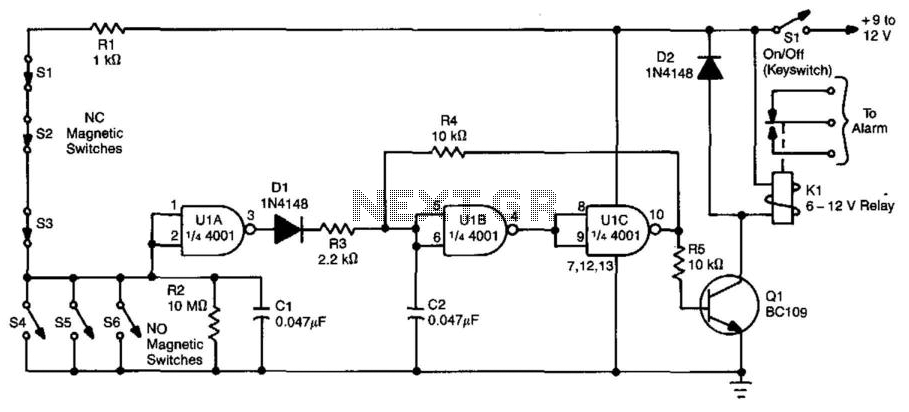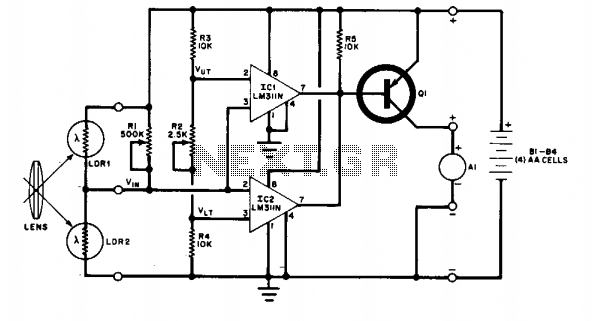
Motorcycle Alarm Number 2

This circuit features an intermittent siren output and automatic reset. It can be operated manually using a key-switch or a hidden switch; but it can also be wired to set itself automatically when you turn-off the ignition. By adding external relays you can immobilize the bike, flash the lights etc. Ron has used my Asymmetric Timer as the basis for his design.
The described circuit employs an asymmetric timer, which is a versatile component in timing applications. The primary function of this circuit is to generate an intermittent siren output, which can be employed in various security applications, particularly in motor vehicles such as motorcycles. The circuit is designed to reset automatically after a specified interval, ensuring that the siren does not remain activated indefinitely.
The operation can be initiated manually through a key-switch or a hidden switch, providing flexibility for the user. This feature allows the circuit to be engaged at the user's discretion, enhancing its usability in different scenarios. Additionally, the circuit has an automatic activation feature that can be wired to the vehicle's ignition system. When the ignition is turned off, the circuit will automatically engage, providing a layer of security against theft.
The integration of external relays expands the functionality of the circuit significantly. These relays can be configured to perform multiple tasks, such as immobilizing the bike, which prevents unauthorized use, or flashing the lights, which serves as a visual deterrent. This adaptability makes the circuit suitable for various applications beyond just siren activation.
The use of the asymmetric timer as the core component is critical to the circuit's performance. This timer can be configured to produce varying duty cycles, allowing for customization of the siren's intermittent output. The precise timing can be adjusted to meet specific requirements, making the circuit versatile for different users and scenarios.
In summary, the circuit is a sophisticated security solution that combines manual and automatic operation modes, with the capability to enhance vehicle security through additional relay functionalities. The design leverages the asymmetric timer to achieve reliable performance in generating an intermittent siren output.This circuit features an intermittent siren output and automatic reset. It can be operated manually using a key-switch or a hidden switch; but it can also be wired to set itself automatically when you turn-off the ignition. By adding external relays you can immobilize the bike, flash the lights etc. Ron has used my Asymmetric Timer as the basis for his design. 🔗 External reference
The described circuit employs an asymmetric timer, which is a versatile component in timing applications. The primary function of this circuit is to generate an intermittent siren output, which can be employed in various security applications, particularly in motor vehicles such as motorcycles. The circuit is designed to reset automatically after a specified interval, ensuring that the siren does not remain activated indefinitely.
The operation can be initiated manually through a key-switch or a hidden switch, providing flexibility for the user. This feature allows the circuit to be engaged at the user's discretion, enhancing its usability in different scenarios. Additionally, the circuit has an automatic activation feature that can be wired to the vehicle's ignition system. When the ignition is turned off, the circuit will automatically engage, providing a layer of security against theft.
The integration of external relays expands the functionality of the circuit significantly. These relays can be configured to perform multiple tasks, such as immobilizing the bike, which prevents unauthorized use, or flashing the lights, which serves as a visual deterrent. This adaptability makes the circuit suitable for various applications beyond just siren activation.
The use of the asymmetric timer as the core component is critical to the circuit's performance. This timer can be configured to produce varying duty cycles, allowing for customization of the siren's intermittent output. The precise timing can be adjusted to meet specific requirements, making the circuit versatile for different users and scenarios.
In summary, the circuit is a sophisticated security solution that combines manual and automatic operation modes, with the capability to enhance vehicle security through additional relay functionalities. The design leverages the asymmetric timer to achieve reliable performance in generating an intermittent siren output.This circuit features an intermittent siren output and automatic reset. It can be operated manually using a key-switch or a hidden switch; but it can also be wired to set itself automatically when you turn-off the ignition. By adding external relays you can immobilize the bike, flash the lights etc. Ron has used my Asymmetric Timer as the basis for his design. 🔗 External reference





